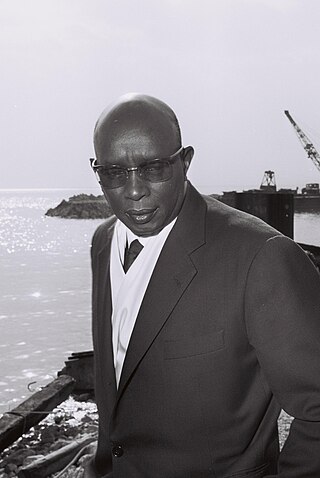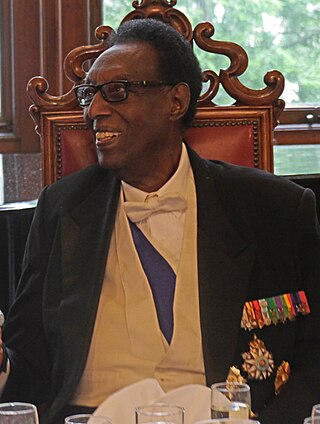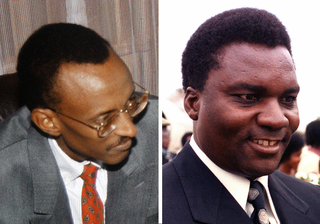Human occupation of Rwanda is thought to have begun shortly after the last ice age. By the 11th century, the inhabitants had organized into a number of kingdoms. In the 19th century, Mwami (king) Rwabugiri of the Kingdom of Rwanda conducted a decades-long process of military conquest and administrative consolidation that resulted in the kingdom coming to control most of what is now Rwanda. The colonial powers, Germany and Belgium, allied with the Rwandan court.

Ntare V of Burundi was the last king of Burundi, reigning from July to November 1966. Until his accession, he was known as Crown Prince Charles Ndizeye.

Paul Kagame is a Rwandan politician and former military officer who has been the fourth President of Rwanda since 2000. He was previously a commander of the Rwandan Patriotic Front (RPF), a rebel armed force which invaded Rwanda in 1990. The RPF was one of the parties of the conflict during the Rwandan Civil War and the armed force which triggered the Rwandan genocide. Kagame's armed forces also carried genocidal massacres against civilians. He was considered Rwanda's de facto leader when he was Vice President and Minister of Defence under President Pasteur Bizimungu from 1994 to 2000 after which the vice-presidential post was abolished.

Mwambutsa IV Bangiricenge was the penultimate king of Burundi who ruled between 1915 and 1966. He succeeded to the throne on the death of his father Mutaga IV Mbikije. Born while Burundi was under German colonial rule, Mwambutsa's reign mostly coincided with Belgian colonial rule (1916–62). The Belgians retained the monarchs of both Rwanda and Burundi under the policy of indirect rule.

Kigeli V Ndahindurwa was the last ruling King (Mwami) of Rwanda, from 28 July 1959 until the end of the UN-mandate with Belgian administration and the declaration of an independent Republic of Rwanda 1 July 1962. On 25 September 1961, a referendum voted for the abolition of the Rwandan monarchy following the Rwandan Revolution.

Ankole was a traditional Bantu kingdom in Uganda and lasted from the 15th century until 1967. The kingdom was located in south-western Uganda, east of Lake Edward.

The Rwandan Civil War was a large-scale civil war in Rwanda which was fought between the Rwandan Armed Forces, representing the country's government, and the rebel Rwandan Patriotic Front (RPF) from 1 October 1990 to 18 July 1994. The war arose from the long-running dispute between the Hutu and Tutsi groups within the Rwandan population. A 1959–1962 revolution had replaced the Tutsi monarchy with a Hutu-led republic, forcing more than 336,000 Tutsi to seek refuge in neighbouring countries. A group of these refugees in Uganda founded the RPF which, under the leadership of Fred Rwigyema and Paul Kagame, became a battle-ready army by the late 1980s.

The Kingdom of Burundi, also known as Kingdom of Urundi, was a Bantu kingdom in the modern-day Republic of Burundi. The Ganwa monarchs ruled over both Hutus and Tutsis. Created in the 16th century, the kingdom was preserved under German and Belgian colonial rule in the late 19th and early 20th century and was an independent state between 1962 and 1966.
The Hororo or Bahororo are a Bantu-speaking ethnicity mainly residing in the north of the former Kigezi District in southwestern Uganda. In 1905, they were described by a British officer as a "quiet, inoffensive people" who owned cattle. They are made up mostly of the Hima ethnic group and the Iru ethnic group. They reside mainly in Rujumbura in southwestern Uganda and are related to the Banyankole, Banyoro, Batooro, Songora and Tutsi peoples respectively. Rujumbura was ruled by the BeeneKirenzi sub-clan with Omukama Karegyesa as their last king. The Bahororo speak a dialect of Nkore-Kiga, Ruhororo. They are subdivided into clans that are similar to those of the kingdom of Ankole. Unlike Ankole, which was ruled by the Hinda clan, Mpororo was led by the Bashambo clan.
Yuhi IV Gahindiro was the King of Rwanda from 1801 to 1845. He was the head of Bahindiro clan and father of Mutara II Rwogera. His reign is remembered in Rwandan history as the most peaceful. He died with no blood on his hands.

On 28 November 1966, Michel Micombero, Burundi's 26-year-old Prime Minister, ousted the 19-year-old king (mwami) of Burundi, Ntare V, in a coup d'état. Ntare was out of the country at the time and the coup leaders quickly succeeded in taking control. Micombero declared an end to the monarchy and the Kingdom of Burundi became a republic, with Micombero as its first President.

On 8 July 1966, a coup d'état took place in the Kingdom of Burundi. The second in Burundi's post-independence history, the coup ousted the government loyal to the king (mwami) of Burundi, Mwambutsa IV, who had gone into exile in October 1965 after the failure of an earlier coup d'état.
Ndahiro II Cyamatare was, according to tradition, Mwami of the Kingdom of Rwanda at the end of the fifteenth century. He was supposed to have reigned between 1477 and 1510, during a period of conflict. He was killed in the Gisenyi district fighting the king of the Bugara, and his son, Ruganzu II Ndoli, succeeded him.
Karagwe Kingdom was a historical Bantu state in present-day Karagwe District of Kagera Region in northwestern Tanzania, between Rwanda and Lake Victoria. East Africa's influential Karagwe Kingdom was ruled by a hereditary monarchs whom were reputed to be Bachwezi descendants. By the end of the 20th century, it had thriving trade with traders from all parts of East Africa, especially slave trading Arabs. Bweranyange served as the Karagwe kingdom's capital.
Kigeli III Ndabarasa was a warrior Mwami of the Kingdom of Rwanda during the eighteenth century. The son of Cyilima II Rujugira, he was raised to be co-ruler by his father before attaining the throne on his death in 1765 or 1786. His reign was marked by military campaigns that expanded Rwandan territory and control. He brought the people of Ndorwa into the kingdom and conquered the small kingdom of Muabli. He expanded the large number of armies he had inherited from his father and founded new armies in Ndorwa and Burundi. He increased support for his military force by creating four new herds of cattle for his army, as well as ten for cattle-herders, and expanded the number of domains for cattle herding into new territories. At the same time, the observance of the practice of veneration for ancestors decreased during his reign. He died due to complications from an operation and was succeeded by his son Sentabyo.
The Bugesera invasion, also known as the Bloody Christmas, was a military attack which was conducted against Rwanda by Inyenzi rebels who aimed to overthrow the government in December 1963. The Inyenzi were a collection of ethnically Tutsi exiles who were affiliated with the Rwandan political party Union Nationale Rwandaise (UNAR), which had supported Rwanda's deposed Tutsi monarchy. The Inyenzi opposed Rwanda's transformation upon independence from Belgium into a state run by the ethnic Hutu majority through the Parti du Mouvement de l'Emancipation Hutu (PARMEHUTU), an anti-Tutsi political party led by President Grégoire Kayibanda. In late 1963, Inyenzi leaders decided to launch an invasion of Rwanda from their bases in neighbouring countries to overthrow Kayibanda. While an attempted assault in November was stopped by the government of Burundi, early in the morning on 21 December 1963, several hundred Inyenzi crossed the Burundian border and captured the Rwandan military in camp in Gako, Bugesera. Bolstered with seized arms and recruited locals, the Iyenzi—numbering between 1,000 and 7,000—marched on the Rwandan capital, Kigali. They were stopped 12 miles south of the city at Kanzenze Bridge along the Nyabarongo River by multiple units of the Garde Nationale Rwandaise (GNR). The GNR routed the rebels with their superior firepower, and in subsequent days repelled further Inyenzi attacks launched from the Republic of the Congo and Uganda.

The Kingdom of Bugesera was an independent Bantu kingdom that existed from the 16th to 18th century in Central Africa. Around 1799, it was conquered and divided by the Kingdom of Rwanda and Kingdom of Burundi.










